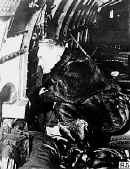 1-2000
1-2000  1-2000
1-2000
Here thanks to OAE Noel Gillespie is some background history.
Comment was made in "Digest 212" re the PBM in 'Operation High
Jump".
During my extensive research in the history of VX-6 and the US Navy's Antarctic
operation for my two part story in "Air Enthusiast" I had extreme
difficulty with any material/information etc. re: "High
Jump" The only person I could locate in the US was Joshua German >Akaky103@aol.com<
, his grandfather was the maintenance aviation officer, sailing south on the USS
Philippine Sea [CVA-47], he contacted me, saying his grandfather's
correspondence went via Wingate NZ.
Part of Task Force 68, under the command of Admiral Richard Byrd and Rear
Admiral Cruzen, the 4.000 men journeyed to the Antarctic in 1946.
Twenty-six aircraft were taken south. I tried unsuccessfully to obtain all
the BuNo's of these, but could only track down a few.
6 R4D's #17238 17197.12415 and 39092.
1 HNS-1 Hoverfly #33585.
2 HOS-1 Hoverflies.
4 HO3S-1 Dragonflies.
1 Noorduyn-Norseman #57992.
2 Grumman J2F-6 Ducks, one was #39045
2 Stinson OY-1 Sentinels.
2 Martin PBM Mariners
and 2 Curtiss SOC Seagulls.
Trigger Hawkes launched the first R4D-5 #17238 successfully from the
flight deck of the Philippine Sea, with Lt. Commander "Gus" Shinn
flying the second R4D-5. The fleet once airborne homed in on the powerful Mt
Olympus radio beacon and landed five hours later on a specially marked airstrip
at Little American, just moments before a strong Antarctic storm blew up,
closing the 'Airport" down.
With regards to the ill fated Martin PBM Mariner flying boat "Marine George
One" which crashed into the Walker Mountains on December 30 1946, it
disintegrated and burned on on impact. Captain Caldwell was thrown clear, but
the aircraft's pilot Ralph Lebance sat unconscious in his burning cockpit with
his clothing on fire. co-pilot Lt. Kearns, Radioman Jim Robbins and crew chief
Bill Warr went back onto the flight deck and pulled him out. Wendell Henderson
was killed instantly at the radio panel and ensign Max Lopex were found dead at
the navigator's table. Flight Engineer Fred William was thrown clear but died
two hours later.
The crew members who survived the crash commenced a long track back to the base-
this is a great story in itself.
With the flying season completed, the command didn't know what to do with
the six R4D-5's, unable to land them back on the carrier. The oil was drained
out along with the removal of classified instruments, they were tied down on the
Ross Sea ice. The following year the USS Icebreakers "Edisto" and
"Burton Island" spotted the Goonies while visiting the Bay of
Whales in early Feb 1948. Snow was cleared away from one of the Douglas aircraft
and its engine started up, but no attempt was made to fly it.
It appeared that a gigantic section of the Ross Sea ice shelf had broken away,
taking with it two thirds of Little America IV, and the stored R4D-5's
drifted away towards their watery grave at the bottom of the Ross Sea.
The outbreak of hostilities in Korea cancelled the planned "Operation
High Jump II".
Noel Gillespie
Christchurch, New Zealand
 Admiral Byrd
dropping flag over South Pole.
Admiral Byrd
dropping flag over South Pole.
 Helecopters from the North Wind.
Helecopters from the North Wind.